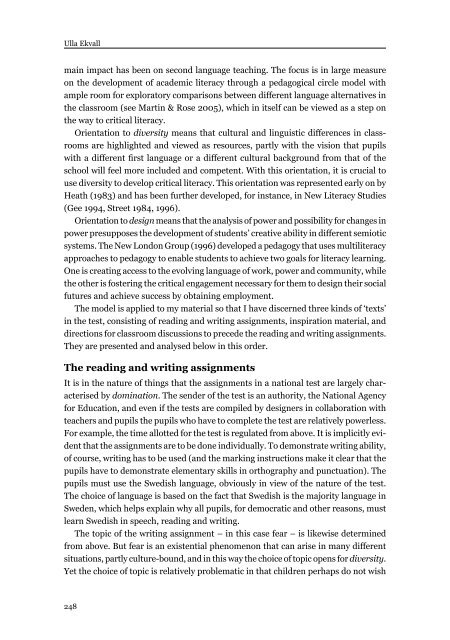Download issue - Umeå universitet
Download issue - Umeå universitet
Download issue - Umeå universitet
You also want an ePaper? Increase the reach of your titles
YUMPU automatically turns print PDFs into web optimized ePapers that Google loves.
Ulla Ekvall<br />
main impact has been on second language teaching. The focus is in large measure<br />
on the development of academic literacy through a pedagogical circle model with<br />
ample room for exploratory comparisons between different language alternatives in<br />
the classroom (see Martin & Rose 2005), which in itself can be viewed as a step on<br />
the way to critical literacy.<br />
Orientation to diversity means that cultural and linguistic differences in classrooms<br />
are highlighted and viewed as resources, partly with the vision that pupils<br />
with a different first language or a different cultural background from that of the<br />
school will feel more included and competent. With this orientation, it is crucial to<br />
use diversity to develop critical literacy. This orientation was represented early on by<br />
Heath (1983) and has been further developed, for instance, in New Literacy Studies<br />
(Gee 1994, Street 1984, 1996).<br />
Orientation to design means that the analysis of power and possibility for changes in<br />
power presupposes the development of students’ creative ability in different semiotic<br />
systems. The New London Group (1996) developed a pedagogy that uses multiliteracy<br />
approaches to pedagogy to enable students to achieve two goals for literacy learning.<br />
One is creating access to the evolving language of work, power and community, while<br />
the other is fostering the critical engagement necessary for them to design their social<br />
futures and achieve success by obtaining employment.<br />
The model is applied to my material so that I have discerned three kinds of ‘texts’<br />
in the test, consisting of reading and writing assignments, inspiration material, and<br />
directions for classroom discussions to precede the reading and writing assignments.<br />
They are presented and analysed below in this order.<br />
The reading and writing assignments<br />
It is in the nature of things that the assignments in a national test are largely characterised<br />
by domination. The sender of the test is an authority, the National Agency<br />
for Education, and even if the tests are compiled by designers in collaboration with<br />
teachers and pupils the pupils who have to complete the test are relatively powerless.<br />
For example, the time allotted for the test is regulated from above. It is implicitly evident<br />
that the assignments are to be done individually. To demonstrate writing ability,<br />
of course, writing has to be used (and the marking instructions make it clear that the<br />
pupils have to demonstrate elementary skills in orthography and punctuation). The<br />
pupils must use the Swedish language, obviously in view of the nature of the test.<br />
The choice of language is based on the fact that Swedish is the majority language in<br />
Sweden, which helps explain why all pupils, for democratic and other reasons, must<br />
learn Swedish in speech, reading and writing.<br />
The topic of the writing assignment – in this case fear – is likewise determined<br />
from above. But fear is an existential phenomenon that can arise in many different<br />
situations, partly culture-bound, and in this way the choice of topic opens for diversity.<br />
Yet the choice of topic is relatively problematic in that children perhaps do not wish<br />
248

















